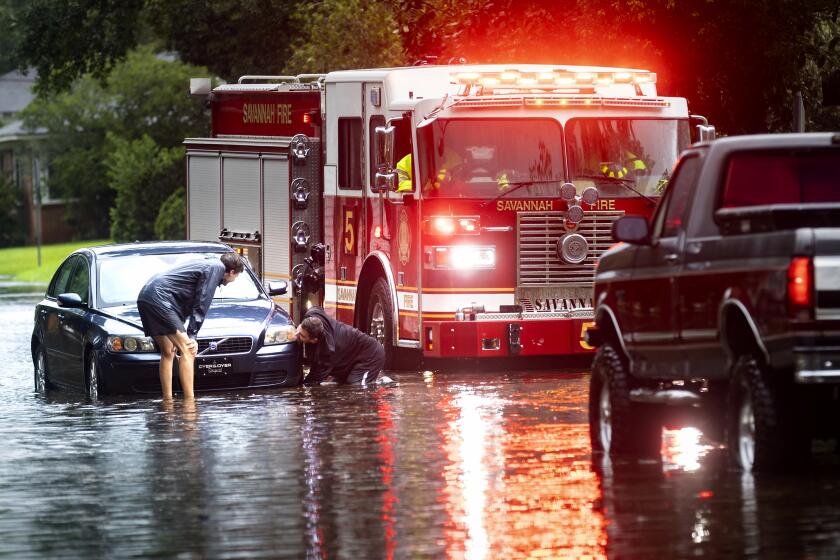With tornado death, Tropical Storm Debby toll rises to at least 7 as heavy rains keep falling

- Share via
LUCAMA, N.C. — Tornadoes spawned by Tropical Storm Debby leveled homes, damaged a school and killed one person early Thursday, as the system dropped heavy rain and flooded communities across North and South Carolina.
It took only 15 seconds for a tornado to devastate Genesis Cooper’s home in Lucama, N.C. He almost slept through it — if not for an alert on his wife’s phone.
The couple and their 20-year-old son huddled in a bathroom with blankets. They felt vibrations and heard glass shattering before hearing a sudden boom.
“I can’t even describe it. It’s like, suction, that’s what it felt like,” Cooper said. “Like something is squeezing, like your ears are popping.”
The tornado was one of at least three reported overnight in North Carolina, and perhaps the most devastating. One person was found dead in a home damaged by the Lucama tornado, Wilson County spokesman Stephen Mann said in an email. No further details on the person were provided.
Parts of the Coopers’ roof and walls were torn off, causing water to leak inside. The side windows were shattered and the backyard pool deck was damaged. “This is just stuff. It can be replaced,” Cooper said. The tornado badly damaged nearby Springfield Middle School.
Meanwhile, about 100 miles south of Lucama, deputies in Bladenboro posted photos of washed-out roads and a patrol car damaged by a fallen tree. Water a few feet deep covered parts of the tiny North Carolina town.
Debby, which made first landfall as a hurricane on Florida’s Gulf Coast early Monday, made its second landfall as a tropical storm in South Carolina early Thursday.
At least seven people have died because of the storm, five of them in traffic accidents or from fallen trees. The sixth death involved a 48-year-old man in Gulfport, Fla., whose body was recovered after his anchored sailboat partially sank.
Debby is expected to churn up the East Coast; residents as far north as Vermont could get several inches of flooding rain this weekend.
Hurricane Debby made landfall in north Florida, bringing the potential for record-setting rains, catastrophic flooding and life-threatening storm surge.
Tropical Storm Debby has brought prolonged downpours to the southeastern United States and could hover over the Atlantic Ocean for the next few days, then boomerang back onto the mainland
Debby dumped rain on communities all the way up to the Great Lakes and New York. As much as 6 inches of rain fell in parts of New Jersey in less than four hours, and New York City officials warned of potential flash flooding, flying drones with loudspeakers in some neighborhoods to tell people in basement apartments to be ready to flee. Multiple water rescues were reported in and around the city.
South Carolina Gov. Henry McMaster said Thursday afternoon that Debby’s effects aren’t completely over because rain falling in North Carolina could swell rivers and cause flooding downstream.
“We’ve passed some dangers, but there’s still plenty,” McMaster said. “So don’t let your guard down yet.”
Back on the coast, Robert Chesnut stood in nearly a foot of water inside his Isle of Palms home with a rented industrial pump that looked like a fire hose. After more than three hours, only about an inch of water had been pulled out of his house on the barrier island near Charleston, S.C.
And once the water is gone, there is still a lot of work to do.
“This is contaminated water,” Chesnut said. “These houses are on septic tanks. I hate to say it, but that’s fecal matter. You have to disinfect everything.”
Seminera and Minchillo write for the Associated Press. AP journalists Jeffrey Collins in Columbia, S.C.; Russ Bynum in Pooler, Ga.; Bruce Shipkowski in Toms River, N.J.; Jeff Martin in Atlanta; and Lisa Baumann in Bellingham, Wash., contributed to this report.
More to Read
Sign up for Essential California
The most important California stories and recommendations in your inbox every morning.
You may occasionally receive promotional content from the Los Angeles Times.














